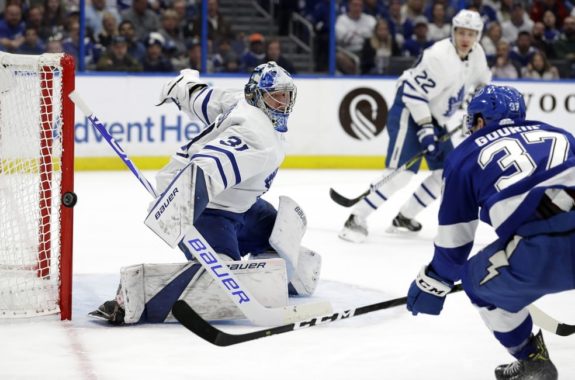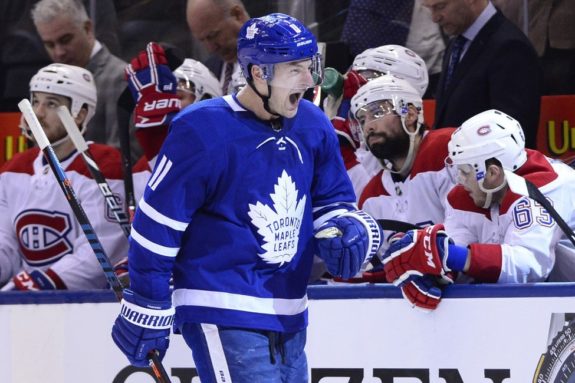
 Eric Cruikshank
The Hockey Writers
Eric Cruikshank
The Hockey Writers
24
Reads
0
Comments
Maple Leafs: Revisiting 3 Pivotal Trades This Decade
While fans of the Toronto Maple Leafs have been critical of the transactions and other managerial decisions that have been made over the years, there have been some significant trades made within the last 10 seasons that have given the Leafs the potential to now be competitive for a long period of time.
This team is built like no other Maple Leaf team before it, and as this decade of Leafs’ hockey comes to a close, it is time to look back at some of the trades that have built this extremely talented roster.
Phil Kessel to the Penguins – July 1, 2015
Maple Leafs Acquire: Kasperi Kapanen, Scott Harrington, Nick Spaling, 2016 conditional first-round pick, 2016 third-round pick
Penguins Acquire: Phil Kessel, Tim Erixon, Tyler Biggs, 2016 conditional second-round pick
This trade will hold up as one of the biggest deals in Toronto sports history and was one of the first trades that initiated the brief rebuild that has turned this Maple Leafs team into Stanley Cup contenders.
Phil Kessel was one of the most polarizing players for the Maple Leafs, which is hard to believe considering he was their best player for a long period of time. Kessel scored at least 30 goals in four of his six seasons in Toronto and led the Maple Leafs in scoring every season he played with them, despite being criticized for his lack of work ethic and his offseason habits.

Trading Kessel was important for a couple of reasons. First of all, it showed that a player who leaves the pressure of the Maple Leafs can succeed beyond expectations, as Kessel was instrumental in the Pittsburgh Penguins’ 2016 and 2017 Stanley Cup wins. Secondly, and the most significant part of it, was the acquisition of Kasperi Kapanen.
Kapanen was selected 22nd overall in the 2014 Draft by the Penguins and was expected to be a potential top-six forward in the Leafs organization after the trade happened. He has become just that.
Kapanen has been a huge part of this team as a complementary player to all of the Maple Leafs’ top forwards. His acceleration and willingness to be physical has made him an extremely important part of their deep forward lineup, and has allowed him to excel as a solid winger in the NHL. After signing him to a three-year extension last summer, it became clear that general manager Kyle Dubas believes Kapanen is a key part of the team’s offence.
Frederik Andersen to Maple Leafs – June 20, 2016
Maple Leafs Acquire: Frederik Andersen
Ducks Acquire: 2016 first-round pick, 2017 second-round pick
One of the Leafs’ biggest missing pieces for the first half of the decade was a solid starting goaltender. Despite the long development and time spent with 2006 draft pick James Reimer, who was the starting goaltender for the majority of his time with the Maple Leafs, there were times where there was no definitive number one goalie.
Jonathan Bernier, Jonas Gustavsson, and even Ben Scrivens all had periods of time in Toronto where they had made cases to take over the starting role until former general manager Lou Lamoriello traded for Frederik Andersen.

The Anaheim Ducks felt comfortable making this deal because they were in the process of grooming now two-time all-star John Gibson into their primary goaltender. Andersen and Gibson were jockeying the starting position throughout the 2015-16 season, with Gibson starting just one more game than Andersen, and the fight for the job ended later that campaign.
Both teams greatly benefitted from this trade, as Andersen has become one of the Maple Leafs’ most valuable players and arguably a top-five goalie in the NHL, and John Gibson has had the opportunity to blossom in Anaheim and help them remain competitive in the Western Conference despite their disappointing start this season.
Through his four seasons with the Maple Leafs, Andersen has posted a solid .918 save percentage with a 125-61-29 record and has stolen the show with his incredible flexibility and reaction time on multiple occasions.
Acquiring Andersen was probably the most important trade made for the team in this decade, and if they are ever able to complete the goal of winning a Stanley Cup in front of him, Andersen will enter the conversation as one of the best goalies in Maple Leafs’ history.
Zach Hyman to Maple Leafs – June 19, 2015
Maple Leafs Acquire: Zach Hyman, 2017 conditional seventh-round pick
Panthers Acquire: Greg McKegg
Among the other trades on this list, this is definitely the best value swap in favour of the Maple Leafs.
After being drafted by the Florida Panthers in the fifth round of the 2010 Draft, Zach Hyman slowly began making headlines in the NCAA. Coming off of a season with the University of Michigan Wolverines where he finished in the top 10 in voting for the Hobey Baker Award and led the Big Ten Conference in points with 54 in 37 games, the Maple Leafs acquired the 23-year-old in what would become arguably their best trade win of the decade.
Greg McKegg was a third-round pick of the Maple Leafs in the same draft as Hyman and had not created nearly as much value for himself during his time with the Toronto Marlies. In his last American Hockey League season with Toronto, McKegg put up just 37 points in 62 games, which was actually 10 points less than his previous season.

Since being traded to Florida in the summer of 2015, McKegg has spent 47% of his games played in the AHL with five different organizations. In his 151 NHL games since being traded from Toronto, McKegg has recorded just 28 points and is currently the fourth line centre on the New York Rangers where he averages just 9:53 of ice time per game.
Hyman has played extremely well this season since returning to the lineup after missing the first 19 games while recovering from a torn ACL he suffered in the playoffs last spring. With 14 points through 19 games, Hyman is on pace for a career-high 26 goals and is having his best season in point production, currently averaging 0.74 points-per-game.
While Hyman is not the Maple Leafs’ greatest offensive threat, there have been times in his absence where the role he provides has become noticeably more valuable. Hyman’s ability to create time and space for his linemates using his physicality and energetic style of play has given him the opportunity to consistently play on the top two forward lines for the Maple Leafs.
Final Thoughts
When looked at closer, the Maple Leafs definitely won more trades than they lost throughout the many deals made throughout the past 10 seasons. Lamoriello planted many of the roots for this team to be the young and offensively-gifted group that it has become, and Dubas has taken full advantage of his knowledge of the prospects in their system due to his experience with the Marlies.
With the core group they have grown and developed through some of these transactions, the Maple Leafs have the pieces to be a dominant and competitive team in this league for a long time.
The post Maple Leafs: Revisiting 3 Pivotal Trades This Decade appeared first on The Hockey Writers.
Popular Articles

















































 Blackhawks Chicago
Blackhawks Chicago Panthers Florida
Panthers Florida Penguins Pittsburgh
Penguins Pittsburgh Rangers New York
Rangers New York Avalanche Colorado
Avalanche Colorado Kings Los Angeles
Kings Los Angeles Maple Leafs Toronto
Maple Leafs Toronto Bruins Boston
Bruins Boston Capitals Washington
Capitals Washington Flames Calgary
Flames Calgary Oilers Edmonton
Oilers Edmonton Golden Knights Vegas
Golden Knights Vegas Senators Ottawa
Senators Ottawa Lightning Tampa Bay
Lightning Tampa Bay Flyers Philadelphia
Flyers Philadelphia Islanders New York
Islanders New York Sabres Buffalo
Sabres Buffalo Red Wings Detroit
Red Wings Detroit Devils New Jersey
Devils New Jersey Hurricanes Carolina
Hurricanes Carolina Blue Jackets Columbus
Blue Jackets Columbus Predators Nashville
Predators Nashville Stars Dallas
Stars Dallas Jets Winnipeg
Jets Winnipeg Wild Minnesota
Wild Minnesota Blues St. Louis
Blues St. Louis Mammoth Utah
Mammoth Utah Sharks San Jose
Sharks San Jose Canucks Vancouver
Canucks Vancouver Ducks Anaheim
Ducks Anaheim






